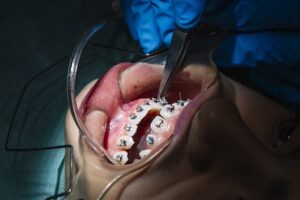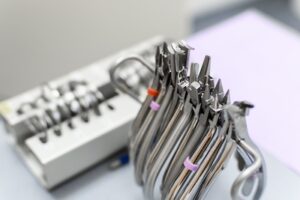
28 Mar Fixing a Broken Orthodontic Wire
Identifying a Broken Orthodontic Wire
Detecting if you have a broken orthodontic wire or it is simply out of place can prevent discomfort and unnecessary concern. With braces, wires may shift and cause you to suspect a breakage. Here’s how you can assess your orthodontic wire’s status.
1. Visually Examine Your Braces
Use a mirror to closely examine your braces. A broken wire will usually have a visible gap or a sharp end pointing out. Compare the suspected breakage area with the rest of your braces; differences in wire continuity are noticeable. If there’s no obvious separation, your wire might just be misplaced or bent, not broken.
2. Feel Around Gently
Carefully use your fingertip or tongue (very gently) to feel around the area you suspect has a broken wire. If you find a pointy end poking out, it’s an indicator that the wire has snapped. However, it’s important to do this gently to avoid injuring yourself or causing further displacement.
3. Check for Mobility
Gently tug at the wire using a clean pair of tweezers. If it feels loose or comes out even more, it may be broken. If the wire remains firm despite a gentle pull, it might just be bent or out of its bracket, which doesn’t always mean a break.
4. Analyze the Symptom
Are you experiencing sudden, increased discomfort or noticing areas in your mouth where the braces didn’t bother you before? While not all discomfort means your wire is broken, a newly broken wire can cause noticeable irritation or scratching sensations inside your mouth.
5. Assess Your Actions Leading Up
Think back on what you were doing when you first noticed the issue. Were you eating hard foods, playing sports without a mouthguard, or brushing too vigorously? Connecting your activities to the onset of discomfort can offer clues on whether you’re dealing with a broken wire.
Taking Action
If you believe your orthodontic wire is broken:
- Apply Dental Wax: Cover any sharp ends with orthodontic wax to protect your mouth.
- Avoid DIY Fixes: Don’t cut the wire or attempt major fixes yourself.
- Call Your Orthodontist: Describe the situation and follow their advice on the next steps.
Identifying a broken orthodontic wire promptly can prevent unnecessary discomfort. Whether it’s a false alarm or an actual breakage, addressing your braces’ issues swiftly with your orthodontic specialist is important for keeping your treatment on track.

Temporary Fixes for a Broken Wire
If you’ve discovered a broken orthodontic wire and have gone through initial steps like checking the wire’s condition and applying dental wax, there are additional steps you can take at home before seeing your orthodontist.
If the wire is causing significant discomfort and dental wax isn’t enough, you might consider gently pushing the wire back into place. Use a clean pair of tweezers to grasp the wire; this can be helpful if the wire has slid out of a bracket. Carefully guide the wire back into the bracket slot. The goal is not to apply force or attempt a permanent fix but to temporarily alleviate discomfort.
If the wire end is protruding but cannot be pushed back into place, creating a buffer can be a quick fix.
- Take a small piece of dental wax and roll it into a ball.
- Flatten the ball slightly and mold it over the protruding end.
This forms a protective barrier between the wire and your mouth, preventing irritation.
Sometimes, the issue can be a loose bracket rather than just the wire. If the bracket is still attached to the wire but has come off the tooth, you can temporarily reposition it. Using tweezers, gently slide the bracket along the wire to a less bothersome position. Cover it with dental wax to hold it in place until your orthodontist can secure it back onto the tooth.
It’s important during this process to maintain oral hygiene.
- Continue brushing your teeth regularly but be cautious around the damaged area.
- Avoid hard or sticky foods that could worsen the issue.
- Choose softer foods that require minimal chewing to avoid any additional pressure on the braces.
After applying these temporary fixes, call your orthodontist’s office as soon as possible. Describe the issue, what measures you’ve taken, and follow their advice on the next steps. They may offer additional guidance over the phone or schedule an appointment to repair the braces properly.
Handling a broken orthodontic wire at home involves gentle, temporary fixes that prioritize comfort and safety. Always combine these immediate steps with prompt communication with your orthodontist to ensure your braces continue to work effectively towards achieving your desired results.

Contacting Your Orthodontist
When experiencing a broken wire on your braces, understanding when and how to inform your orthodontist is important. Here’s a guide to manage the situation effectively:
Identify the Severity
Assess the severity of the break or damage. Minor issues might not cause immediate discomfort but shouldn’t be dismissed. If the wire is causing severe pain, cuts, or other significant issues, it’s a sign to act quickly.
Take Immediate Temporary Measures
Before reaching out to your orthodontist, take temporary measures (if necessary) like using a sterile piece of gauze to cover any sharp ends temporarily.
Timing for Contact
If the broken orthodontic wire is causing discomfort but isn’t an emergency, try to call during business hours. For severe pain or risk of injury, many orthodontic offices offer an emergency contact number or after-hours service.
How to Communicate
- Be Precise:
When you call, be precise about the issue. Describe where the wire has broken, which tooth it’s affecting, and any measures you’ve already taken, such as applying dental wax. - Explain Symptoms:
Briefly describe any symptoms you’re experiencing as a result of the broken wire, like discomfort, difficulty eating properly, or irritation in the mouth. - Describe Urgency:
Let them know how urgent the situation feels to you based on your discomfort or difficulty managing daily activities. - Request Guidance:
Ask for immediate steps you should take while waiting for your appointment. The office may offer additional tips to manage the situation more comfortably. - Provide Availability:
Offer your availability for an appointment. Being flexible can help you get a prompt visit.
Tools for Communication
- Phone Call: The most direct way to inform your orthodontist and seek advice.
- Email or Online Portals: If the situation isn’t urgent, using an email or the orthodontist’s patient portal can be effective. Include detailed information and, if possible, a photo of the affected area.
Preparation for Appointment
Before attending your appointment, prepare a summary of any significant details regarding the break and any actions taken since noticing it. This can help your orthodontist assess and fix the issue more efficiently.

Follow-Up
After the initial contact and before your appointment, if the situation worsens or additional concerns arise, don’t hesitate to call back. Your comfort and safety are important.
Maintaining open and honest communication with your orthodontic team is key to managing any issues with your braces effectively. They’re there to help ensure your orthodontic treatment goes as smoothly as possible.


Sorry, the comment form is closed at this time.